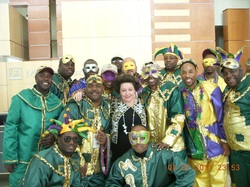
When the Mammoth Parade takes to the streets on Fat Tuesday, Big Mary will have her arms open to greet the crowds. Over 8 feet tall, head thrown back in jubilation, Big Mary rides on the front of "The Mollies" -- a float that’s an annual part of the Mobile Area Mardi Gras Association’s festivities.
With her buddy Hotfoot Sam -- a towering gent in striped pants and top hat -- she is a symbol both of carnival fun and MAMGA tradition.
The Mollies were once flesh and blood -- a group of people in the 1940s who dressed up like comic characters and joined the procession, said Eric Finley, a MAMGA officer.
At the MAMGA float barn recently, Finley walked along the parade line-up, arriving at The Mollies.
Big Mary and Hotfoot Sam loomed over the fanciful creation.
Pictures of other Mollies were painted on the float’s sides.
“They came from the bottom,” he said, referring to an area near the old city dump, in the north part of town.
Finley describes them as natural entertainers.
Hotfoot Sam, for example, as the story goes, walked on hot, ground glass just to amuse folks.
“Slewfoot Joe walked like this,” Finley said, spreading his feet wide to demonstrate.
Slewfoot Joe, on the back of The Mollies float, hangs on to a tall pole.
The historical Mollies turned MAMGA’s procession into “a people’s parade,” said Sheila Flanagan, assistant director of the History Museum of Mobile.
“They would dress up in discarded clothing — that’s why you see them looking tattered and torn. They were a spoof on the royalty and majesty we portray in the court.”
Dora Finley, a Mobile historian, saw the Mollies when she was a little girl in the 1950s.
Her father once took her and her brother to “the bottom” to see them for real.
“He said,” Dora Finley recalled, “‘I want you to see that, but for the grace of God, this could be you.’”
Her father also taught her, she said, that the dwellers in that hard-luck neighborhood had created their own social order, including a king and queen.
“The queen had a special necklace and a fancy blouse, and they had their own society,” she said.
And on Mardi Gras day, when the Mollies left their homes and arrived at Davis Avenue for the MAMGA festivities -- now Martin Luther King, Jr. Avenue -- they became celebrities.
“They’d paint their faces and put on cake powder and heavy lipstick,” she said.
Children were fascinated and delighted by them -- but also scared.
Clapping their hands and dancing down the street, the Mollies frightened some, she said.
Dora’s mother, Joycelyn Franklin Finley, 85, knows for a fact that the Mollies depicted on the Mollies float “were all characters in the neighborhood.”
But where did the name Mollies come from?
The elder Finley remembers how the children teased entertainers.
They ran behind them shouting:
“Molly Molly cottontail/Take your tail/And go to jail.”
In the Walt Disney version of “B’rer Rabbit,” Molly Cottontail was B’rer Rabbit’s girlfriend.
The Mammoth Mollies give that folklore a hometown, carnival twist.
With her buddy Hotfoot Sam -- a towering gent in striped pants and top hat -- she is a symbol both of carnival fun and MAMGA tradition.
The Mollies were once flesh and blood -- a group of people in the 1940s who dressed up like comic characters and joined the procession, said Eric Finley, a MAMGA officer.
At the MAMGA float barn recently, Finley walked along the parade line-up, arriving at The Mollies.
Big Mary and Hotfoot Sam loomed over the fanciful creation.
Pictures of other Mollies were painted on the float’s sides.
“They came from the bottom,” he said, referring to an area near the old city dump, in the north part of town.
Finley describes them as natural entertainers.
Hotfoot Sam, for example, as the story goes, walked on hot, ground glass just to amuse folks.
“Slewfoot Joe walked like this,” Finley said, spreading his feet wide to demonstrate.
Slewfoot Joe, on the back of The Mollies float, hangs on to a tall pole.
The historical Mollies turned MAMGA’s procession into “a people’s parade,” said Sheila Flanagan, assistant director of the History Museum of Mobile.
“They would dress up in discarded clothing — that’s why you see them looking tattered and torn. They were a spoof on the royalty and majesty we portray in the court.”
Dora Finley, a Mobile historian, saw the Mollies when she was a little girl in the 1950s.
Her father once took her and her brother to “the bottom” to see them for real.
“He said,” Dora Finley recalled, “‘I want you to see that, but for the grace of God, this could be you.’”
Her father also taught her, she said, that the dwellers in that hard-luck neighborhood had created their own social order, including a king and queen.
“The queen had a special necklace and a fancy blouse, and they had their own society,” she said.
And on Mardi Gras day, when the Mollies left their homes and arrived at Davis Avenue for the MAMGA festivities -- now Martin Luther King, Jr. Avenue -- they became celebrities.
“They’d paint their faces and put on cake powder and heavy lipstick,” she said.
Children were fascinated and delighted by them -- but also scared.
Clapping their hands and dancing down the street, the Mollies frightened some, she said.
Dora’s mother, Joycelyn Franklin Finley, 85, knows for a fact that the Mollies depicted on the Mollies float “were all characters in the neighborhood.”
But where did the name Mollies come from?
The elder Finley remembers how the children teased entertainers.
They ran behind them shouting:
“Molly Molly cottontail/Take your tail/And go to jail.”
In the Walt Disney version of “B’rer Rabbit,” Molly Cottontail was B’rer Rabbit’s girlfriend.
The Mammoth Mollies give that folklore a hometown, carnival twist.